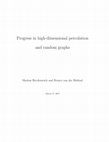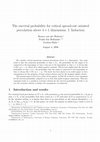Papers by Remco van der Hofstad

CRM Short Courses, 2017
These lecture notes focus on percolation on high-dimensional lattices. We give a general introduc... more These lecture notes focus on percolation on high-dimensional lattices. We give a general introduction to percolation, stating the main results and defining the central objects. We assume no prior knowledge about percolation. This text is aimed at graduate students and researchers who wish to enter the wondrous world of high-dimensional percolation, with the aim to demystify the lace-expansion methodology that has been the key technique in high dimensions. This text can be used for reading seminars or advanced courses as well as for reference and individual study. The exposition is complemented with many exercises, and we invite readers to try them out and gain deeper understanding of the techniques presented here. Let us now summarize the content in more detail. We describe mean-field results in high-dimensional percolation that make the intuition that "faraway critical percolation clusters are close to being independent" precise. We have two main purposes. The first main purpose is to give a self-contained proof of mean-field behavior for high-dimensional percolation, by proving that percolation in high dimensions has mean-field critical exponents β = γ = 1, δ = 2 and η = 0, as for percolation on the tree. This proof is obtained by combining the Aizenman-Newman and Barsky-Aizenman differential inequalities, that rely on the triangle condition, with the lace-expansion proof of Hara and Slade of the infrared bound that, in turn, verifies the triangle condition. While there exists expository texts discussing lace-expansion methodology, such as Slade's excellent Saint-Flour lecture notes, an introduction to highdimensional percolation did not yet exist. Aside from these classical results, that are now over 25 years old, our second main purpose is to discuss recent extensions and additions. We focus on (1) the recent proof that mean-field critical behavior holds for percolation in d ≥ 11; (2) the proof of existence of arm exponents; (3) results on finite-size scaling and percolation on high-dimensional tori and their relationship to the Erdős-Rényi random graph; (4) extensions of these finitesize scaling results to hypercube percolation; (5) the existence of the incipient infinite cluster and its scaling properties, as well as the proof of the Alexander-Orbach conjecture for random walks on the high-dimensional incipient infinite cluster; (6) the novel lace expansion for the two-point function with a fixed number of pivotals; and (7) superprocess limits of critical percolation clusters. The text is enriched with numerous open problems, which, we hope, will stimulate further research in the field. This text is organised as follows. In Part 1, consisting of Chapters 1-3, we introduce percolation and prove its main properties such as the sharpness of the phase transition. In Part 2, consisting of Chapters 4-9, we discuss mean-field critical behavior by describing the two main techniques used, namely, differential inequalities and the lace expansion. In Parts 1 and 2, all results are proved, making this the first self-contained text discussing high-dimensional percolation. In Part 3, consisting of Chapters 10-13, we describe recent progress in high-dimensional percolation. We provide partial proofs and give substantial v vi PREFACE overview and heuristics about how the proofs are obtained. In many of these results, the lace expansion and differential inequalities or their discrete analogues are central. In Part 4, consisting of Chapters 14-16, we discuss related models and further open problems. Here we only provide heuristics and few details of the proofs, thus focussing on the overview and big picture. This text could not have been written without help from many. We are grateful to Kilian Matzke, Andrea Schmidbauer, Gordon Slade, Si Tang, Sebastian Ziesche, as well as the reading groups in Geneva and Sapporo for valuable comments and pointing out typos and omissions in an earlier version of the manuscript. Special thanks go to Robert Fitzner, who kindly prepared the graphics in these lecture notes.

We consider critical spread-out oriented percolation above 4+1 dimensions. Our main result is tha... more We consider critical spread-out oriented percolation above 4+1 dimensions. Our main result is that the extinction probability at time n (i.e., the probability for the origin to be connected to the hyperplane at time n but not to the hyperplane at time n + 1) decays like 1/Bn 2 as n → ∞, where B is a finite positive constant. This in turn implies that the survival probability at time n (i.e., the probability that the origin is connected to the hyperplane at time n) decays like 1/Bn as n → ∞. The latter has been shown in an earlier paper to have consequences for the geometry of large critical clusters and for the incipient infinite cluster. The present paper is Part I in a series of two papers. In Part II, we derive a lace expansion for the survival probability, adapted so as to deal with point-to-plane connections. This lace expansion leads to a nonlinear recursion relation for the survival probability. In Part I, we use this recursion relation to deduce the asymptotics via induction.
Uploads
Papers by Remco van der Hofstad